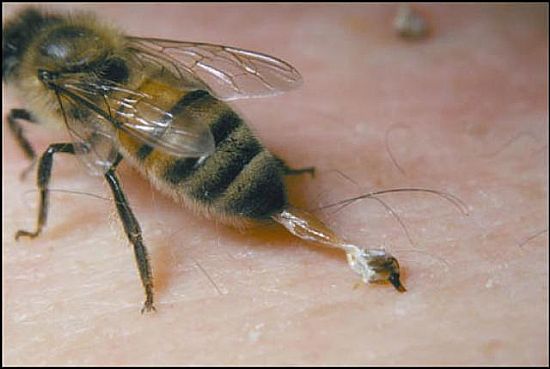Allergy First Aid: Treating Bee Stings
A worker bee leaving it's stinger in it's human victim. Note the stinger is still at this point attached to the bee as it's pulling away after stinging. The bee will soon die of massive haemorrhage.
This student allows herself to be stung in order we can see how the stinger is left in the arm and to show the poison sack still pumping venum into her.
If the video does not play once you click on the box then please click on the open content in a new window message.
Bee stings are normally just painful however in a few people they can cause a life threatening reaction if the victim is allergic to the venom.
The best way to reduce any reaction to bee venom is to remove the bee stinger as quickly as possible. If a bee sting victim has had any allergic reactions to bee stings in the past, consider the possibility of anaphylaxis, a life-threatening allergic reaction.
Treatment
• Safety first! Get away from the bee. Bees release a scent when in danger to attract other bees. If you're still around when reinforcements get there, they'll sting you.
• Follow universal precautions and wear personal protective equipment if you have it.
• Remove any stingers immediately! No need to scrape off bee stingers, just remove them. It's okay to pull stingers out with your fingers. The longer bee stingers are allowed to remain in the body, the more severe the reaction will be.
• If the victim is allergic to bees, check to see if the victim is carrying an epinephrine auto-injector (EpiPen®). If so, help the victim use the device as directed. If the victim is supposed to carry one of these devices and does not have it, call 999 immediately! Do not wait for symptoms to appear.
Watch any victim closely for signs of anaphylaxis:
• itching
• redness
• hives (raised welts)
• shortness of breath
• If there is any concern that the victim may be developing anaphylaxis, call 999 immediately. Antihistamines, such as diphenhydramine (Benedryl®), can slow an anaphylactic reaction, but will not stop it.
• Non-allergic victims will almost always develop local reactions to bee stings. Redness, swelling, and pain are all common at the site of the bee sting. The pain will usually go away pretty quickly, but swelling may last for more than a day. Use an ice pack to reduce swelling at the site. It's common to develop some itching at the bee sting site. Antihistamines or calamine lotion should help.
• Take the victim to the emergency department if the victim was stung more than ten times, or if there are bee stings inside the nose, mouth, or throat. Swelling from these stings can cause shortness of breath, even in non-allergic victims.
• Use ibuprofen or acetaminophen for minor pain relief. For tenderness at the site, try a bee-sting swab to dull the pain.
Conventional wisdom says to scrape bee stingers away from the skin because pinching the venom sack could push extra venom into the victim. In fact, how fast you get the stinger out is much more important than how.
Honey bees leave a stinger behind when they sting a victim. Wasps, yellow jackets, and hornets do not leave a stinger.
These relatives of the honey bee can also cause an anaphylactic reaction.
Below is a video showing how to preform CPR on an adult.
Below is a video showing how to preform CPR on a child or infant.
(in this video the rescuer uses a mask to help him give the rescue breaths to the child, mouth to mouth is how most people would carry this out as not everyone carries a mask with them (he is a lifeguard, so he does).

